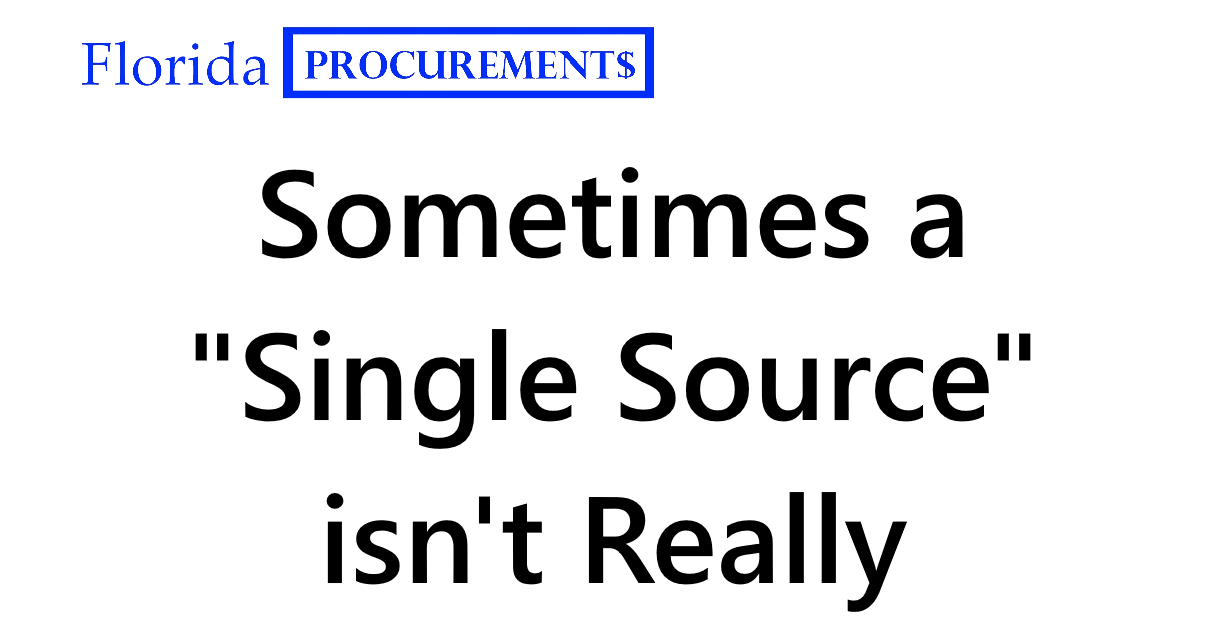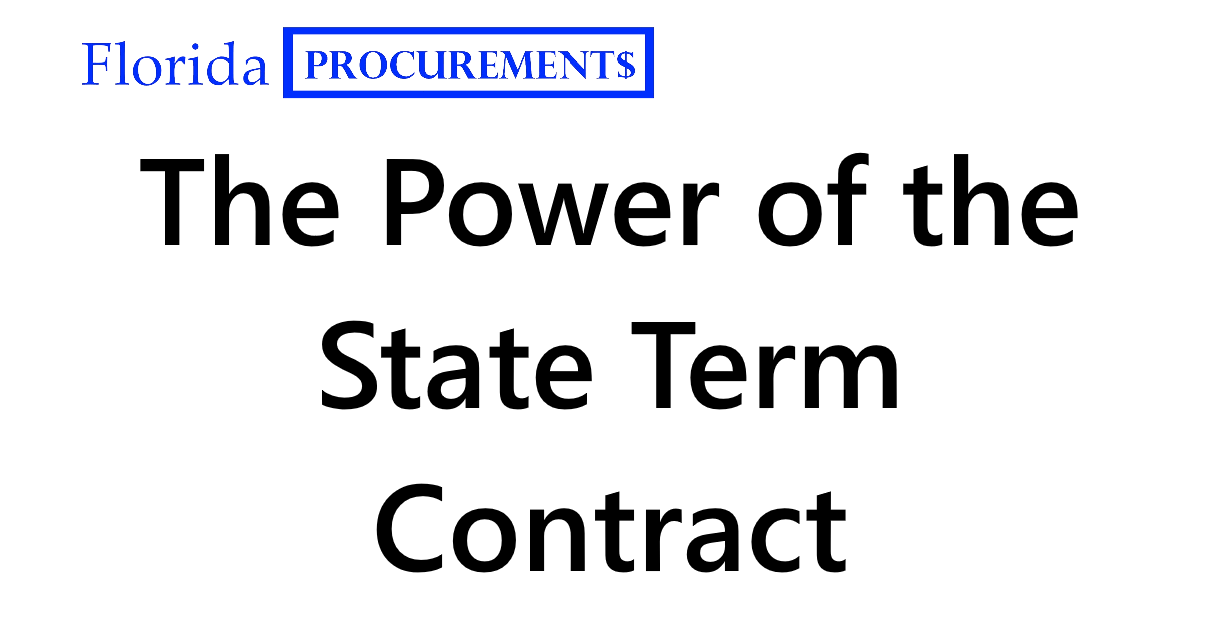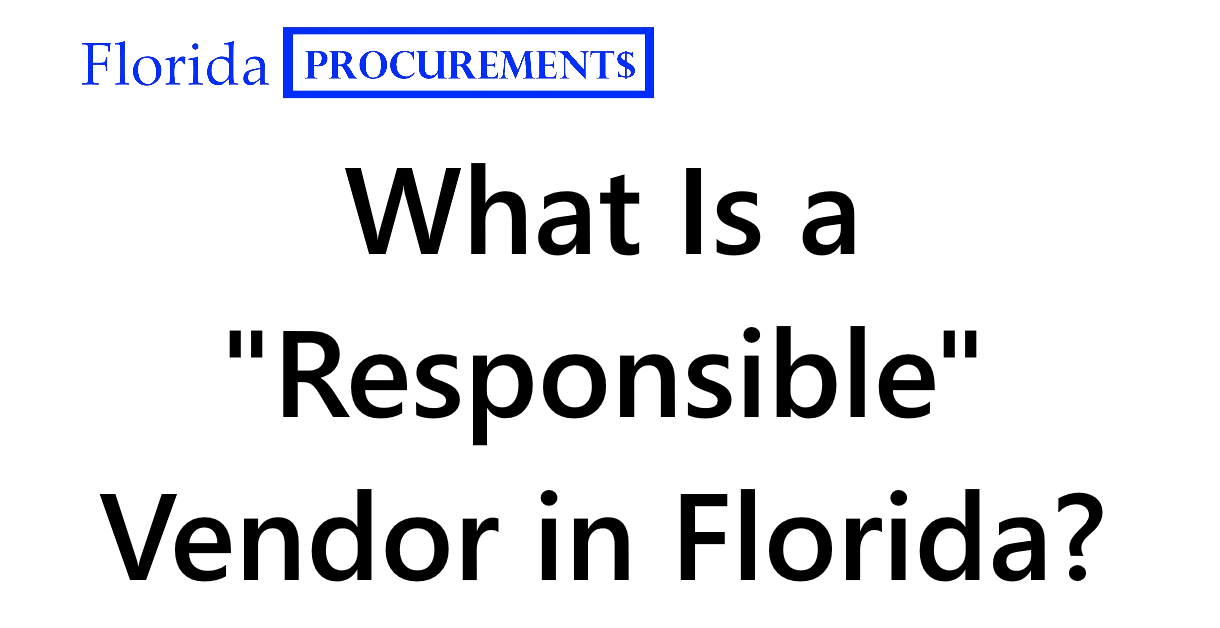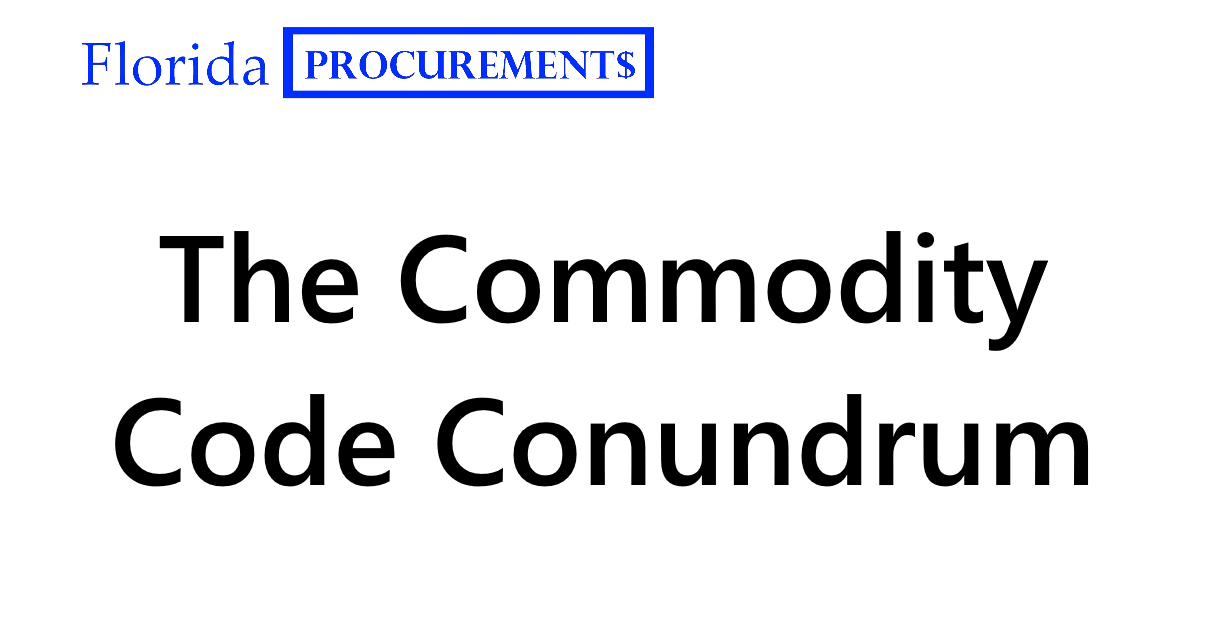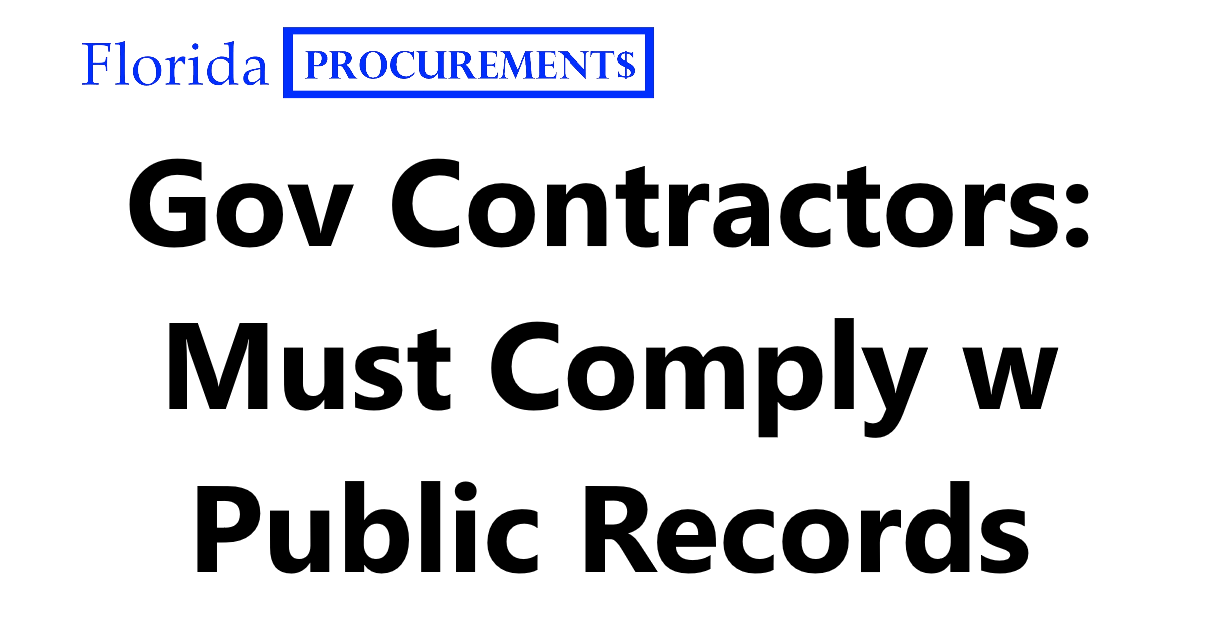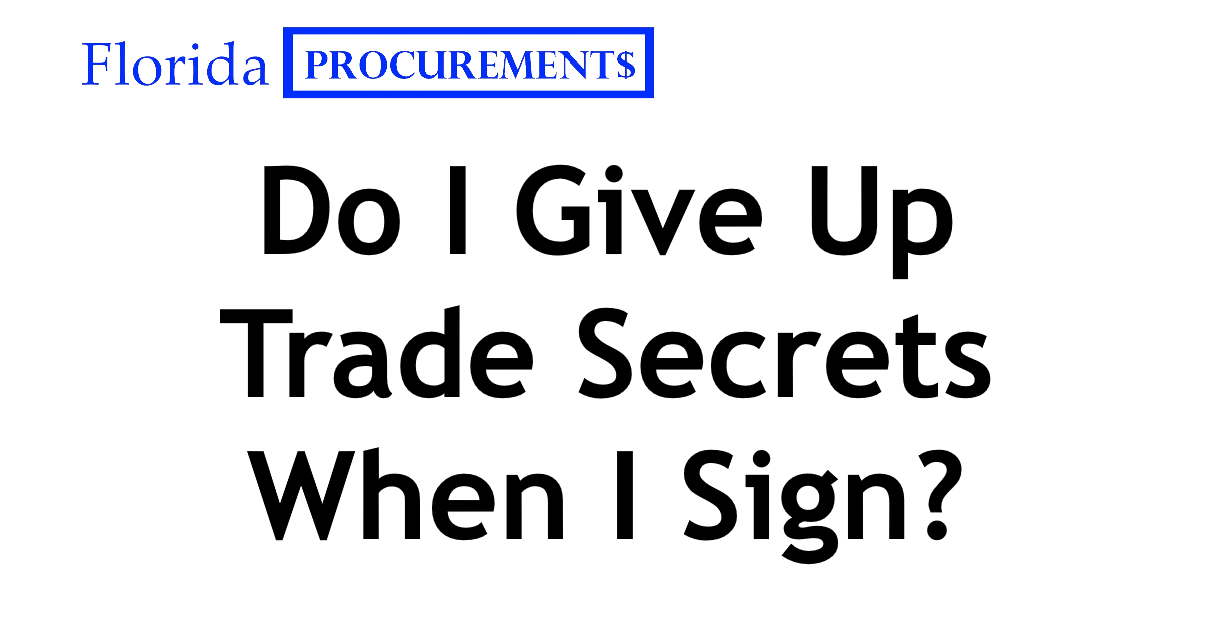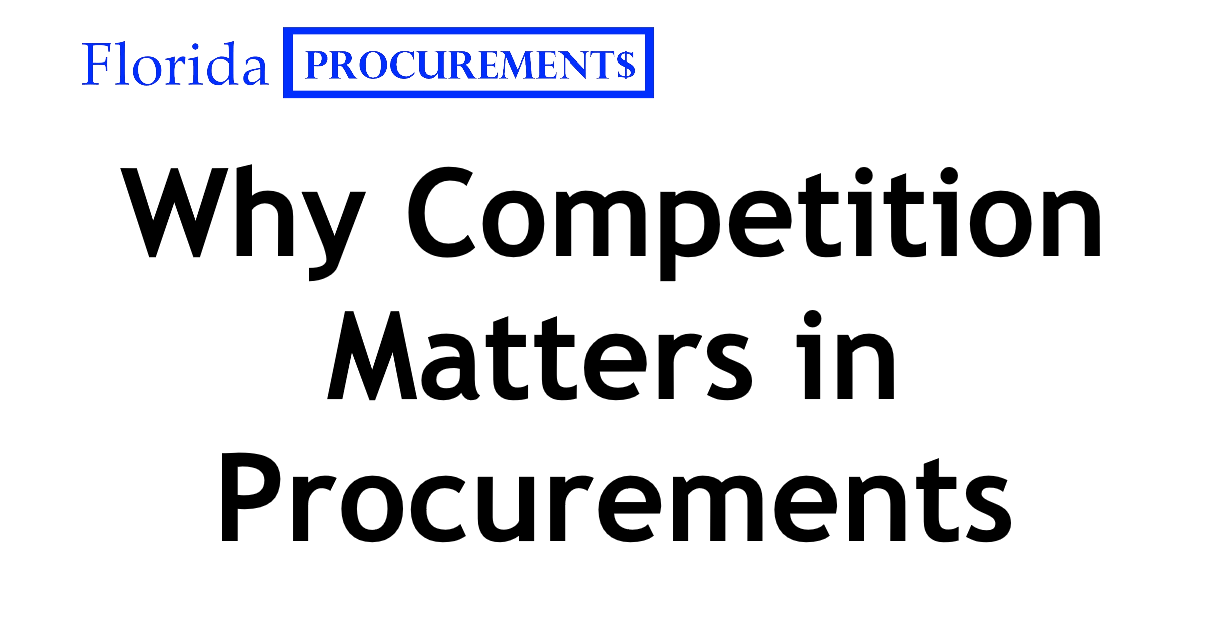
- March 13, 2025
- Sean Gellis
- 0
Welcome to FloridaProcurements.com (FlaProc), your authoritative resource for navigating Florida’s government contracting landscape, with particular focus on transportation and technology opportunities. FlaProc provides free, expert guidance to help companies identify and secure state contracting opportunities throughout Florida.
This resource is maintained by Attorney Sean Gellis of Gellis Law, PLLC, one of less than 75 attorneys Board Certified in State and Federal Government and Administrative Practice by The Florida Bar. Mr. Gellis brings unique insight to government contracting, having served as the Chief of Staff of the Florida Department of Management Services (DMS), General Counsel of the Florida Department of Transportation (FDOT), and Deputy General Counsel of the Florida Office of Insurance Regulation – positions that provided direct oversight of technology initiatives and issues of statewide importance. His record in bid protest litigation reflects the sophisticated advocacy and strategic thinking he brings to government contracting matters, particularly in complex transportation and technology procurements. Sean also leads Procurement Insider, a confidential subscription service that provides technology vendors with strategic intelligence and insider analysis of Florida government opportunities. Learn more about transforming your approach to government contracting at www.gellislaw.com/procurement-insider
Why All These Rules Exist in the First Place

In the daily hustle of government procurement – parsing complex RFPs and ITNs, navigating protest deadlines, and untangling the intricacies of contract terms – it’s easy to lose sight of the fundamental question: Why do we have procurement regulations at all?
The answer seems obvious to procurement professionals: to ensure fair and open competition. But this principle, so frequently cited it’s become almost a throwaway line, deserves deeper examination. As alternate procurement methods proliferate and competitive bidding increasingly faces workarounds, it’s worth revisiting why competition matters and what’s at stake when we bypass it.
The Evolution of Procurement Laws: A Response to Scandal
Florida’s procurement framework didn’t emerge fully formed from legislative theory. Each major component evolved in direct response to specific abuses of public trust and taxpayer dollars. Understanding this history illuminates why seemingly burdensome rules exist.
The modern competitive procurement system has roots in the scandals of the 1970s and early 1980s, when a series of investigations revealed systematic favoritism in state contracting. The 1974 Implementation of the General Appropriations Act included the state’s first comprehensive procurement code in response to allegations that contracts were being steered to politically connected vendors. The 1985 reforms, including the consultant competitive negotiation requirements, followed revelations about no-bid contracts awarded to former agency officials.
More recently, the early 2000s saw significant procurement reforms after investigations revealed that certain technology contracts had been awarded without meaningful competition to vendors with connections to agency leadership. Each scandal followed a similar pattern: competition was bypassed, connections mattered more than competence, and taxpayers ultimately paid the price through higher costs or failed projects.
These aren’t ancient history or rare exceptions. During my tenure at DMS, I witnessed multiple attempts to circumvent competitive requirements to benefit connected vendors. Without the procedural safeguards in place, many of these attempts would have succeeded.
The Core Purpose: Preventing the Inevitable

At its heart, procurement regulation exists because of a simple reality of human nature and power: without guardrails, those with decision-making authority naturally favor their connections. This isn’t cynicism – it’s pragmatism born from centuries of observation.
As former Supreme Court Justice Louis Brandeis famously noted, “Sunlight is said to be the best of disinfectants.” Competitive procurement provides that sunlight. Without it, the default isn’t efficient contracting—it’s favoritism, nepotism, and corruption.
The natural tendency toward favoritism manifests in several predictable ways in government contracting:
The Friend-of-a-Friend Syndrome
Without competitive requirements, contracts gravitationally flow toward those with personal connections to decision-makers. I’ve seen agency heads suddenly discover an “urgent need” for consulting services that, coincidentally, could only be provided by former colleagues or political allies. The competitive process disrupts this natural networking effect by requiring objective consideration of all qualified vendors.
The Incumbent Advantage
Existing vendors develop relationships with agency staff and gain insider knowledge about agency needs and preferences. Without forced competition, this creates a powerful inertia that keeps contracts with incumbents regardless of performance or cost. The competitive bidding process periodically resets this advantage by requiring incumbents to re-prove their value proposition against the market.
The Political Donor Effect
Campaign contributions create an expectation of reciprocity that can influence procurement decisions when safeguards are absent. During budget cycles, I’ve observed the remarkable correlation between major campaign donors and sudden agency interest in their products or services. Procurement regulations create a documentary record that makes such connections harder to disguise.
The Revolving Door Problem
Former agency officials who transition to the private sector bring valuable relationships and insider knowledge. Without competitive requirements, they can leverage these advantages to secure contracts for their new employers. Procurement regulations create procedural barriers that limit the impact of these connections on contract awards.
Each of these patterns emerges naturally in the absence of procedural constraints. The procurement system isn’t designed to solve theoretical problems – it addresses these documented, recurring tendencies that undermine the public interest.
The Growing End-Run Around Competition
Despite these hard-learned lessons, we’re witnessing a concerning trend: the proliferation of procurement methods that bypass competitive bidding. While each alternative method serves legitimate purposes in specific circumstances, their expansion threatens to undermine the core benefits of competition.
Alternate Contract Sources (ACS): The Borrowed Competition Problem
The ACS process allows Florida agencies to “piggyback” on contracts competitively procured by other states or cooperative purchasing organizations. In theory, this leverages competition that has already occurred. In practice, it often circumvents Florida-specific requirements and limits competition from Florida-based businesses.
During my time at DMS, I reviewed ACS requests. While many were legitimate, others raised serious concerns:
- Contracts with specifications tailored to other states’ needs being applied to Florida’s distinct requirements
- Old contracts with outdated pricing being extended through the ACS process rather than rebid
- Contracts with minimal competition in their original procurement being used to avoid Florida’s more robust competitive requirements
The ACS process serves a valuable function when properly used, but its expansion from exception to common practice undermines the benefits of true competition.
Cooperative Purchasing: Competition at Arm’s Length
Cooperative purchasing vehicles like NASPO ValuePoint offer economies of scale and reduced administrative burden. However, they also remove procurement decisions from local oversight and competitive processes. This creates several concerning dynamics:
- Reduced opportunity for Florida-based small and medium businesses that may not have the resources to compete for massive national contracts
- Diminished ability to customize requirements to Florida’s specific needs
- Less transparency in the evaluation and award process
- Competitive processes that occur far from Florida stakeholders’ observation or input
The growth of cooperative purchasing hasn’t just changed how contracts are awarded – it’s changed who can realistically compete for government business, often to the detriment of local enterprises.
GSA Schedules: Federal Solutions for State Problems
The use of federal GSA schedules by state agencies offers access to pre-negotiated pricing from a wide range of vendors. However, it also introduces several competitive distortions:
- Federal contracting preferences and requirements that may not align with state priorities
- Evaluation criteria that didn’t consider Florida-specific needs or conditions
- Pricing structures negotiated for federal volume that may not represent the best value for state-level purchasing
- Reduced opportunities for businesses focused on state and local markets
The convenience of GSA schedules comes at the cost of procurement tailored to Florida’s specific market conditions and policy priorities.
The Shift in Power: From Evaluation Committees to Lobbyists
As competitive procurement faces more bypasses, the procurement landscape has fundamentally shifted. The race is no longer primarily between competing vendors offering the best value, but between lobbyists vying to influence agency decisions on exempt purchases.
This transformation manifests in several troubling ways:
The Pre-Procurement Lobbying Push
Rather than focusing on developing superior proposals for competitive solicitations, vendors increasingly invest in lobbying activities aimed at steering agencies toward non-competitive procurement methods that favor their solutions. I’ve observed vendors dedicating more resources to influencing the procurement method than to improving their product or service offerings.
The “Sole Source Justification” Industry
An entire consulting niche has emerged focused on helping vendors secure sole source designations that exempt them from competitive requirements. These consultants specialize not in demonstrating vendor superiority, but in crafting justifications that navigate legal requirements while avoiding meaningful market tests.
The Budget Line-Item Strategy
Connected vendors increasingly bypass procurement entirely by securing specific budget line items that effectively mandate their selection. By the time the procurement office becomes involved, the vendor has already been selected through the budget process, rendering competition moot. This environment creates structural advantages for vendors with lobbying resources regardless of solution quality.
The Technology Procurement Challenge
Technology procurement presents unique challenges that don’t always align well with traditional competitive models. The legitimate need for flexibility in technology acquisition has become a justification for bypassing competition altogether. For more information, read my article on the need for Florida IT procurement reform.
When Flexibility Truly Matters
Several aspects of technology procurement genuinely benefit from more flexible approaches:
- Rapidly Evolving Requirements: Technology needs can change significantly between solicitation development and contract award
- Solution Discovery: Agencies sometimes need collaborative problem-solving rather than responses to predetermined specifications
- Integration Complexity: Existing systems create technical dependencies that may limit viable options
- Iterative Development: Agile development methods don’t align with traditional fixed-price contracting models
These legitimate challenges require thoughtful procurement adaptations that maintain competitive principles while accommodating technology realities.
When “Flexibility” Masks Predetermination
Unfortunately, the need for flexibility has become a blanket justification for avoiding competition in technology procurement. I’ve observed several concerning patterns:
- “Unique” requirements drafted specifically to match a predetermined vendor’s capabilities
- Pilot projects intentionally designed to create dependency on specific vendors for full implementation
- Technical evaluations conducted by staff with existing relationships or preferences for particular vendors
- “Market research” consisting exclusively of demonstrations from preselected vendors
The complexity of technology procurement creates perfect cover for steering contracts toward favored vendors while maintaining the appearance of diligence and objectivity.
The Innovation Paradox
Agencies increasingly cite the need for innovative solutions as justification for non-competitive methods. Ironically, this approach often reduces innovation by limiting the diversity of solutions considered and creating environments where political connections matter more than technical excellence.
True innovation thrives in competitive environments where diverse approaches compete on their merits. The most innovative technology solutions I’ve seen in government emerged from competitive processes that focused on outcomes rather than prescriptive specifications.
When Bypassing Competition Makes Sense (Legitimately)
This isn’t to suggest competitive procurement is always the answer. There are legitimate scenarios where alternative methods serve the public interest:
True Emergencies and Critical Timelines
When public health, safety, or essential government functions face imminent risk, the time required for competitive procurement may create unacceptable consequences. Hurricane response, public health crises, and critical infrastructure failures legitimately require expedited procedures.
The key distinction is between genuine emergencies and administrative convenience. True emergencies involve imminent risks to public welfare, not political or bureaucratic discomfort.
Genuine Market Limitations
In rare cases, only one vendor can realistically meet specialized requirements due to proprietary technology, unique capabilities, or exclusive rights. These situations are significantly rarer than sole source justifications suggest, but they do exist.
The test should be whether market limitations are genuine or artificial. Many apparent “unique” requirements result from accumulated decisions that created vendor dependency rather than inherent market limitations.
The Value Proposition of “Burdensome” Guardrails
Competitive procurement is undeniably more time-consuming. It requires detailed specifications, formal evaluation processes, and careful documentation. It introduces protest risks and can delay implementation. In some cases, the rigid focus on objective criteria may even result in selecting a vendor that doesn’t offer the best subjective value.
Despite these drawbacks, the guardrails serve essential purposes that extend far beyond the individual procurement:
System Integrity vs. Transaction Efficiency
The efficiency conversation typically focuses on individual transactions rather than system integrity. While competitive procurement may introduce costs and delays for specific purchases, it protects the integrity of the government procurement system as a whole. This system-level protection delivers value that transcends individual transactions.
During my tenure in government, I observed that agencies most resistant to competitive processes often ended up with the least effective contracts and most expensive implementations over time. The initial efficiency gained by bypassing competition frequently led to long-term value losses through vendor lock-in, scope expansion, and diminished leverage in contract management.
The Transparency Benefit
Competitive procurement creates a documentary record that enables meaningful oversight and accountability. This transparency serves multiple constituencies:
- Taxpayers gain visibility into how their money is spent
- Oversight bodies can review decisions for compliance and reasonableness
- Vendors receive feedback that improves future offerings
- Agency staff can demonstrate the integrity of their decisions
- Future administrations inherit documented decision rationales
This transparency creates value beyond the immediate procurement by building institutional knowledge and public trust.
The Public Trust Dividend
Public confidence in government contracting has tangible value. When citizens believe contracts are awarded fairly rather than through connections, they develop greater trust in government operations generally. This trust facilitates public-private partnerships, encourages quality vendors to pursue government business, and reduces friction in government operations.
The perception of fairness matters as much as actual fairness in maintaining this trust. Competitive procedures provide visible evidence of fairness that builds and maintains public confidence.
The Agency Staff Protection Function
Procurement regulations protect agency staff from undue influence and pressure. Clear procedures and documentation requirements create boundaries that shield procurement professionals from demands to favor connected vendors.
This protection isn’t just about individual integrity, it’s about creating an environment where procurement decisions can focus on value rather than relationships. The most effective procurement professionals I’ve worked with embraced competitive procedures as tools that empowered them to secure the best value for their agencies.
The Innovation Stimulus
Contrary to claims that competition stifles innovation, properly structured competitive procurement actually stimulates innovation by:
- Forcing incumbent vendors to continuously improve their offerings
- Creating opportunities for new market entrants with innovative approaches
- Exposing agencies to diverse solutions rather than single-vendor perspectives
- Rewarding substantive innovation rather than relationship management
The most innovative government implementations I’ve observed emerged from competitive processes that focused on outcomes rather than prescriptive requirements.
Finding the Balance: Competition as the Default, Not the Exception

The solution isn’t eliminating alternative procurement methods – it’s restoring their proper place as exceptions rather than defaults. This means developing a procurement ecosystem that maintains competitive benefits while allowing appropriate flexibility.
Strengthening Oversight of Alternative Methods
Alternative procurement methods require enhanced scrutiny precisely because they lack the inherent checks of competitive processes:
- ACS Approvals: Require demonstration that out-of-state competitive processes adequately protected Florida interests and included comparable competition
- Sole Source Justifications: Require documented market research conducted by procurement professionals rather than program staff with vendor relationships
- Cooperative Purchasing: Evaluate whether cooperative vehicles truly represent the best value compared to Florida-specific competition
These oversight mechanisms need not create excessive bureaucracy, but should provide appropriate counterbalance to the natural tendency toward non-competitive convenience.
Deploying Innovative Competitive Models
Traditional sealed bidding isn’t the only form of competition. Innovative competitive models can address many of the legitimate challenges agencies face:
- Phased Competitions: Allow progressive down-selection that maintains competition while accommodating solution refinement
- Proof-of-Concept Stages: Enable practical demonstration of concepts while maintaining competitive pressure
- Outcome-Based Specifications: Focus on results rather than methodologies to encourage innovation within competitive frameworks
- Agile-Friendly Frameworks: Structure competitions around team capabilities and methodologies rather than fixed deliverables
These approaches maintain essential competitive elements while addressing the legitimate need for flexibility in complex procurements.
Improving Efficiency Within Competitive Frameworks
Much of the resistance to competitive procurement stems from inefficiencies in implementation rather than inherent flaws in the competitive model:
- Standardized Documentation: Develop consistent templates and requirements that reduce administrative burden
- Process Streamlining: Eliminate unnecessary steps while maintaining competitive integrity
- Professional Development: Invest in procurement staff capabilities to improve efficiency and effectiveness
- Technology Enablement: Implement systems that reduce administrative burden while enhancing transparency
The choice between competition and efficiency is often false – both can be achieved through thoughtful process design and implementation.
Reinforcing the Burden of Justification
The default should be competition, with alternatives requiring affirmative justification:
- Escalating Approval Requirements: Implement progressive approval levels based on contract value and competitive impact
- Documentation Standards: Establish clear standards for justifying departures from competitive processes
- Transparency Requirements: Make alternative procurement justifications publicly available for scrutiny
- Accountability Mechanisms: Hold approving officials responsible for outcomes of non-competitive decisions
This approach maintains flexibility while creating appropriate incentives to use competitive processes when feasible.
Enhancing Transparency Across All Methods
If alternative methods are to coexist with competitive procurement, they must incorporate comparable transparency:
- Consistent Documentation: Apply similar documentation standards to all procurement methods
- Public Visibility: Make non-competitive procurement documents as accessible as competitive solicitations
- Decision Rationales: Require and publish explanations for key decisions in non-competitive processes
- Outcome Tracking: Monitor and report results of all procurement methods to enable comparative evaluation
Transparency doesn’t guarantee good decisions, but it creates conditions where poor decisions are more likely to be identified and corrected.
Addressing the Counterarguments

Advocates for reduced competitive requirements offer several compelling arguments that deserve thoughtful response:
“Competition Is Too Slow for Modern Needs”
The pace of competitive procurement is a legitimate concern, particularly for technology acquisitions in rapidly evolving environments. However, this argument often conflates process problems with competition itself. Many delays in competitive procurement stem from poor planning, excessive specification detail, or administrative inefficiency rather than inherent competition requirements.
The solution is streamlining competitive processes, not abandoning competition. When agencies invest in procurement planning and capability development, competitive timelines can align with operational needs while maintaining essential safeguards.
“We Need Relationships, Not Just Transactions”
Government contracting benefits from collaborative vendor relationships rather than purely transactional interactions. Non-competitive methods seemingly facilitate these relationships by enabling direct vendor selection based on relationship quality.
However, this argument misunderstands the purpose of competition. Effective competitive procurement evaluates relationship factors like past performance, collaborative approaches, and communication capabilities. The best competitive processes select for relationship quality rather than ignoring it.
More importantly, relationships built on competitive selection tend to be healthier than those originating from connections or influence. When vendors earn business through demonstrated value rather than access, the resulting relationships focus on continued performance rather than maintained influence.
“Specialized Knowledge Justifies Continuity”
Vendors with experience working with an agency develop specialized knowledge about its operations, needs, and challenges. This knowledge creates efficiency that new vendors cannot immediately match, seemingly justifying continued non-competitive awards to incumbents.
This argument overlooks how competitive pressure improves incumbent performance. The knowledge advantage of incumbency is real, but without competitive pressure, this advantage often leads to complacency rather than excellence. Regular competition forces incumbents to continuously improve while creating opportunities for fresh approaches.
“Avoiding Protests Justifies Alternative Methods”
Competitive procurements create protest risk that can delay implementation and consume agency resources. Alternative methods seemingly avoid this risk by limiting competitive rights.
This argument fundamentally misunderstands the purpose of protest provisions. Protests aren’t a bug in the competitive system – they’re a feature that ensures accountability and compliance. The solution to protest concerns is conducting proper competitions that withstand scrutiny, not avoiding the scrutiny altogether.
The Bottom Line: Competition Still Matters

Procurement rules may seem like bureaucratic obstacles, but they represent hard-earned lessons about protecting the public interest. The core principle – that open competition delivers better value and prevents corruption – remains as true today as when Florida’s procurement laws were first established.
As procurement professionals, agency leaders, and vendors, we should approach alternatives to competition with appropriate caution. Convenience and speed are valuable, but they don’t outweigh the fundamental benefits of fair, open competition.
When we find ourselves frustrated by the requirements of competitive procurement, it’s worth remembering the alternative isn’t some idealized, efficient contracting utopia – it’s a system where connections matter more than competence and where public resources too easily flow to those with influence rather than those offering value.
The guardrails exist for a reason. They may sometimes slow us down, but they keep us on the road.
Sean Gellis is a Board Certified specialist in State and Federal Government and Administrative Practice with over a decade of government experience, including service as General Counsel of the Florida Department of Transportation and Chief of Staff of the Department of Management Services. Through Gellis Law, PLLC, he provides strategic counsel on government procurement, administrative law, and regulatory matters.


